
Curator’s statement
I came to Patagonia curious—drawn by the light, the silence,, and the sheer scale of the landscape. Traveling with photographers taught me to see more intentionally, to notice what often goes unseen. Every place, every pause, became part of a deeper shift in how I move through the world. This journey didn’t just change what I saw—it changed how I see.
The Fora Difference
Book with Norma to access exclusive perks and experiences on your trip.
Killer perks
Free upgrades, spa credits and more—we got you
Personalized recs
Customized travel planning for your style
Insider knowledge
Expert advice from people who’ve actually been there
Where to stay
Unlock perks by contacting Norma to book your trip.
Day 1: Arrival in Buenos Aires – tango, flea markets, & our first Argentine feast

After a smooth landing in Buenos Aires, I’m greeted right away by my roommate Kerstin. We had already been in touch via WhatsApp before the trip—and somehow, she spots me instantly in the crowd. Instantly likable.
Since a few others from our photo tour are arriving later with a different airline, we pass the time at a nearby Starbucks. First chats, first impressions. We’re a group of ten, from Switzerland, Austria, and Germany—a colorful, friendly mix of people with cameras and curiosity.
Lisa, our organizer and guide, welcomes us warmly and gives us a quick rundown of the day. First stop: the hotel to drop off our luggage – check-in isn’t until 3 pm—and then we dive right in: exploring Buenos Aires on foot, starting with the historic district of San Telmo.
San Telmo is one of the city’s oldest neighborhoods – rich in history, full of character, and buzzing with creative energy. Many of the buildings date back to the 19th century, protected as historical landmarks, with that perfectly imperfect, slightly crumbling charm I love so much.
Once a prestigious area, San Telmo changed drastically after a yellow fever outbreak. Today, it’s a haven for artists, musicians, and tourists—and for anyone wanting to see Buenos Aires beyond its broad boulevards.
We wander through its narrow streets, visit the Mercado de San Telmo, and of course, try our first empanadas! The market is alive—a heady mix of aromas, color, and soul. And meat. So much meat. Here, steak isn’t just eaten—it’s revered.
I’m so enchanted by the vibe that I later split off from the group to wander on my own for a bit. But not before we all visit the legendary flea market at Plaza Dorrego. Every Sunday, this square transforms into a treasure trove of boxes, trunks, stalls, and stories. Antiques, art, kitsch, and icons—Evita, Maradona, Che, the Pope—they’re all here. Add live music from every corner, and you’ve got sensory overload in the best way.
I decided to linger. I find a spot on the square, order a beer, and simply take it all in. The music, the people, the pulse. And everywhere: Tango. Not for show – but real, raw, soulful. Danced by locals who carry it in their bones. If I had to imagine Argentina in a single moment — it would be this. Tango was born in Buenos Aires’ brothels in the late 19th century and rose to fame in the 1920s with artists like Carlos Gardel. But it’s not just a dance — it’s a feeling, rhythm, history. As tango teacher Giovanni Pugliese once said: “Tango is the most authentic form of Argentine folk music. It was and still is a reflection of our daily reality.” I think he’s absolutely right.
Later that evening, we gathered for our first Argentine dinner — unsurprisingly, heavy on the meat and red wine. Peter from Switzerland is celebrating his birthday, so the night ends with a toast, laughter, and full hearts.
A perfect first day. Well-fed, well-traveled, and already in love with Argentina.
Day 2: City tour of Buenos Aires – flu vibes & a full program
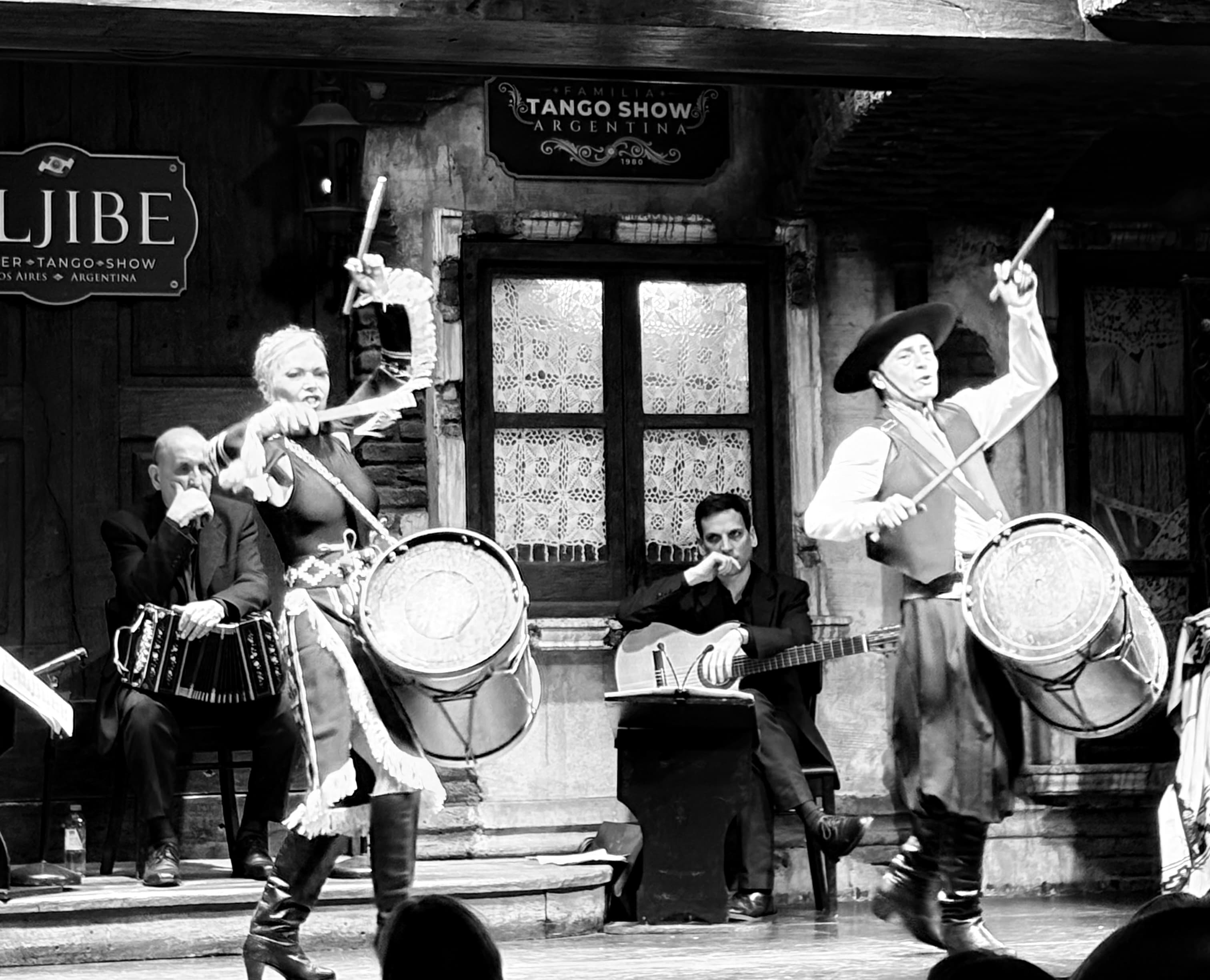
Aljibe tango
I’m feeling a bit under the weather today—kind like the start of the flu. Can I make it through the day? Let’s see...
We start in the historical center at the iconic Plaza de Mayo. On one side stands the grand cathedral, and right across from it, the legendary Casa Rosada—the pink presidential palace. Visually striking, architecturally impressive, and politically charged. In contrast, the whitewashed Cabildo, the old town hall with its bell tower, feels almost modest.
A serious and moving moment on the square: the Mothers of Plaza de Mayo. Every Thursday for decades, they’ve gathered here with white headscarves to remember their children and grandchildren who disappeared during the military dictatorship. It’s a powerful reminder of Argentina’s dark past—something that really stays with you.
From there, we dive back into the vibrant chaos of the city. Buenos Aires is massive—nearly 3 million people live here, and with the surrounding metro area, it’s closer to 15 million. One in three Argentinians is a Porteño – a true capital dweller. And you feel it immediately: this is the cultural, political, and economic heartbeat of the country—and it beats loudly.
Next, we visit the legendary neighborhood of La Boca—once a working-class port district in the south of the city. Originally built by Italian immigrants using scrap from shipwrecks, today it’s a riot of color: bright wooden, iron, and tin houses in every shade imaginable. The United Colours of La Boca, you could say. It’s a little quirky, a little kitschy—with tango dancers, cafés, and street art everywhere—but absolutely one-of-a-kind.
For lunch, we stop at a cozy café and have Tarta de Limón. I take it easy, though—my stomach isn’t quite cooperating today. Thankfully, we got a short break afterwards, and I’m genuinely grateful. I really need a moment to recharge.
The afternoon brings one of the day’s highlights: the over 100-year-old Teatro Colón, one of the most beautiful opera houses in the world. Above-ground, it fills an entire city block—but underground, it’s even more impressive: three full levels of backstage opera world! We even get lucky and catch part of a rehearsal – pure goosebumps.
In the evening, there’s one more classic on the agenda: a traditional tango show. I’m pretty wiped out by now, but I hang in there—and it’s so worth it. Passion, music, melancholy—this dance is Buenos Aires.
Late that night, I collapsed into bed—completely exhausted, but happy. Fingers crossed I feel better tomorrow. But one thing is already clear: Buenos Aires has completely won me over. Some clichés turn out to be true:
Tango isn’t just a show—it’s an emotion.
Football is a religion.
And the steaks? No words needed.
Day 3: The journey to Patagonia begins!
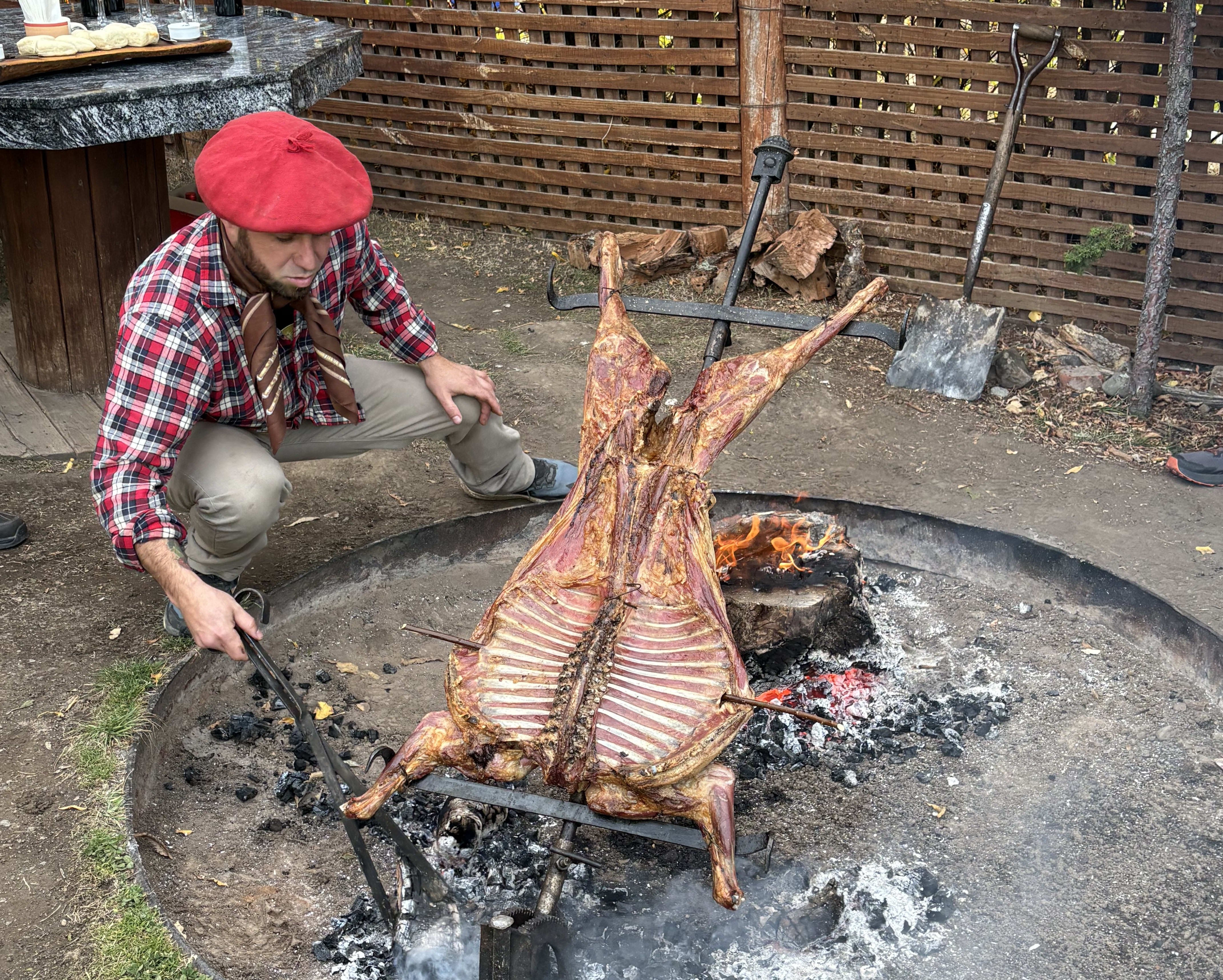
I’m feeling much better—just in time for the next leg of the adventure. At 9 am, we’re picked up and head to the airport for our flight to El Calafate, the gateway to the famous Perito Moreno Glacier. After three hours in the air and a bit of airport logistics, it’s late afternoon by the time we finally check into the hotel—and just like that, the travel day is done.
But the evening brought a true highlight: a friend of Lisa’s has prepared grilled Patagonian lamb for us — and let me tell you, it tastes every bit as amazing as it sounds! There’s also fantastic red wine, homemade empanadas, and more potato salad than anyone could possibly eat.
Welcome to Patagonia
Of course, the most important part of this stop is the Perito Moreno Glacier. It is one of the most beautiful sights in South America, maybe even the world. They say every South American should see it at least once in their life. And people from all over the globe travel here just to stand at the edge of this immense, living wall of ice.
But more on that tomorrow.
Tonight, we’re taking it slow — soaking in the atmosphere, enjoying the food, and getting our first impressions of the wild southern frontier.
I can’t wait for what’s next.
Day 4: Perito Moreno – the glacier that moves

The day starts early – 7 am sharp. We’re picked up and head straight into the national park. Outside, it’s still pitch dark and freezing cold. Classic Patagonian autumn. There’s a crispness in the air—that first hint of snow, like a quiet promise. A light mist drifts across the landscape, and on the horizon, the mountain range appears only faintly through the haze. From it, a massive glacier tongue winds its way 30 kilometers down through the valley—ending right at our feet in a towering ice wall, 70 meters high, carved with deep cracks and crevices.
It looks like something from another world. The Perito Moreno Glacier glows in pale turquoise, streaked with silvery grays—almost unreal in its beauty. Then suddenly, a thunderous crack breaks the silence. A chunk of ice crashes from the wall into Lago Argentino below, sending a deep boom across the water. And in that exact moment, you feel it—that raw, untamed power of nature. The wild energy of our planet.
While most glaciers around the world are slowly disappearing, Perito Moreno was long considered an exception—a glacier that didn’t retreat but actually advanced. But even here, things are changing. In recent years, Perito Moreno has also started to slowly shrink. Not as dramatically as many others, but unmistakably. A quiet sign that even the seemingly eternal aren’t invincible. And maybe that’s what makes this moment so special: Knowing we’re witnessing something that won’t always be here. A fleeting glimpse into our planet’s past – and maybe also its future.
I could write so much more about this day—but you know what? I’ll let the photos do the talking. It’s absolutely breathtaking.
Day 5: Sunrise to sunset in El Chaltén – chasing light and mountains
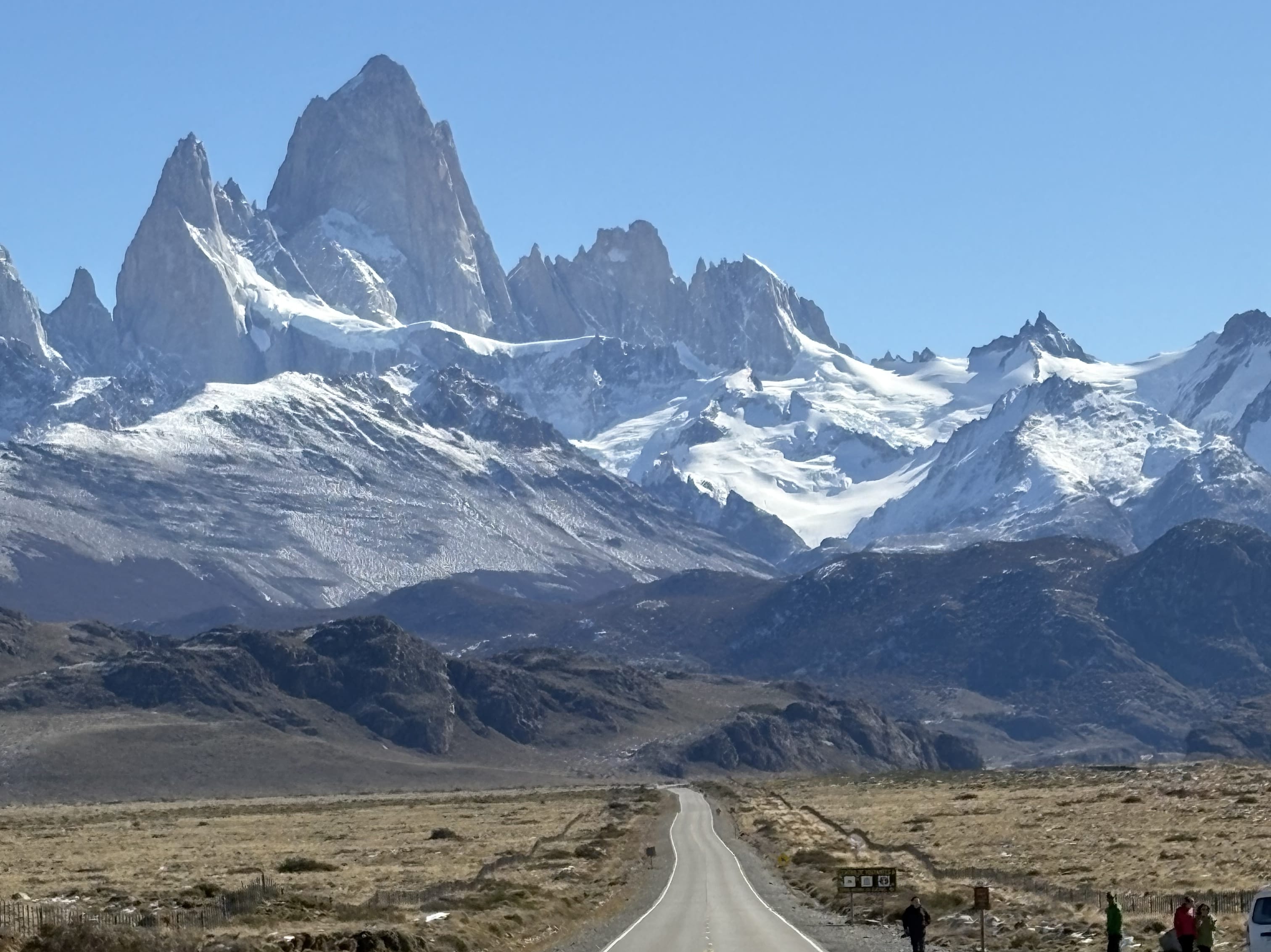
We’re picked up before sunrise—the plan: head to El Chaltén. Normally, the drive from El Calafate takes about three hours. But today? It’ll take us six. Why? Simple: We’re with photographers. And that means one thing: every time a particularly beautiful rock, a perfect streak of mist, or a guanaco in ideal light appears, we stop. And we stop every time.
El Chaltén is located in the northern part of Los Glaciares National Park—the southern part stretches all the way down to El Calafate. The park is massive: about 6,000 square kilometers, and home to over 300 glaciers. It’s an incredibly stunning, one-of-a-kind landscape in the world. The closer we get to El Chaltén, the more the scene changes. Quaint, alpine-style bars sell ice-cold Argentine beer to mountaineers waiting for the perfect weather window for their next expedition. Everywhere you look, young backpackers in bright outdoor gear, hikers with huge backpacks, and adventure in their eyes.
We drive along the legendary Ruta 40, heading straight for Mount Fitz Roy—it’s a view fit for the gods. The distinctive granite giant juts out dramatically from the Fitz Roy massif. Alongside the Cerro Torre, this vertical rock needle, the whole thing almost seems unreal. Both are among the world’s most challenging peaks—and today, both are showing themselves to us in clear skies. Jackpot!
Naturally, we stop to take photos at every opportunity. Stop, get out, marvel, shoot – repeat. We’re in the flow. By late afternoon in El Chaltén, there’s no time to check into the hotel—we’re off to the next mountain to capture the evening light. The catch? The round trip takes another three hours. That means we don’t get back to the hotel until late—and dinner is at classic Argentine time: really late.
Tomorrow, it’s another early start—we’re chasing the sunrise on the local mountain.
Day 6: 6 am alarm – up the mountain!
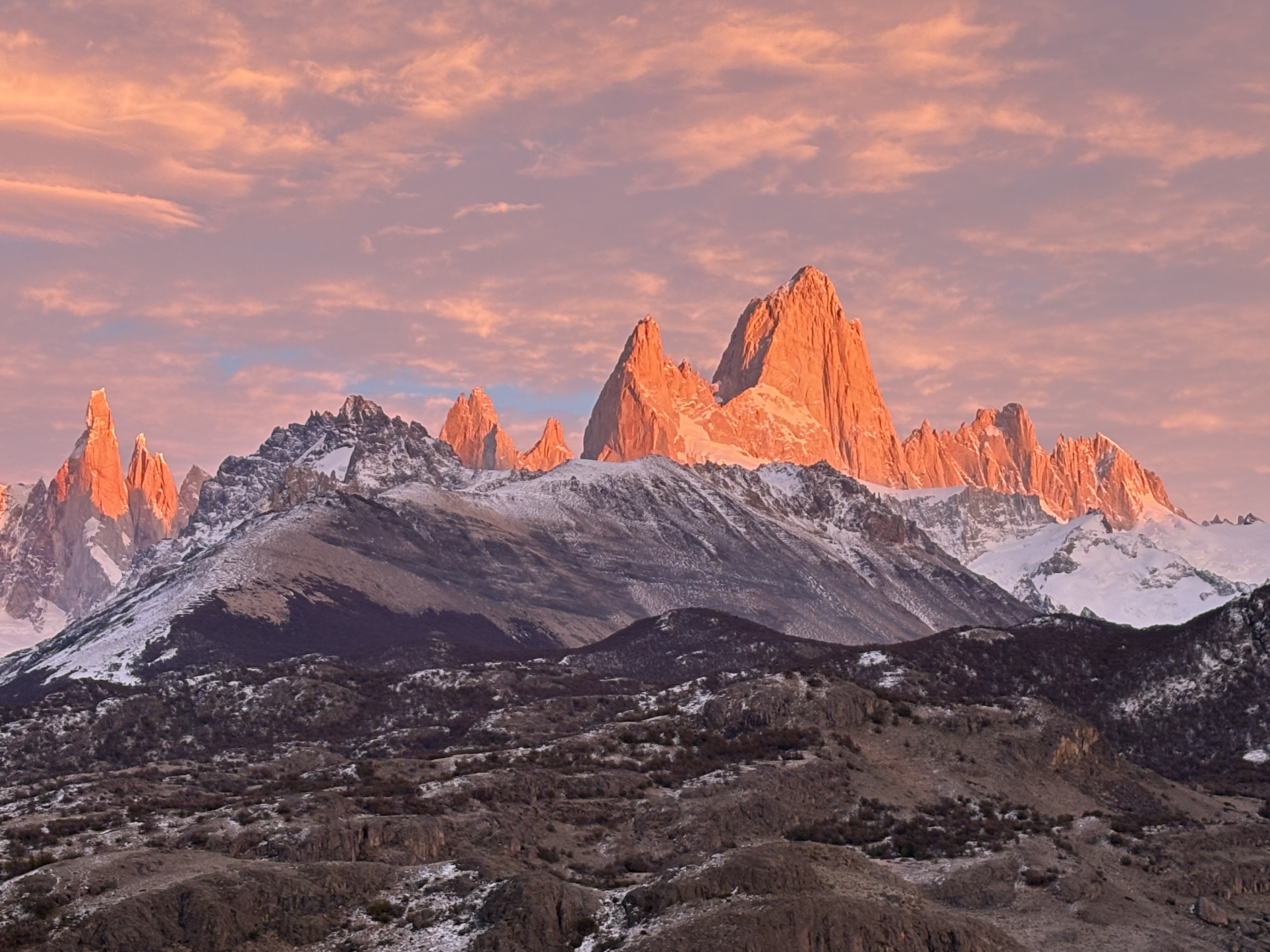
I’m starting to get a feel for how the next few days will unfold around here…The small town of El Chaltén was only founded in 1985 – as a sort of “base camp” for adventurers, right at the foot of the Fitz Roy Massif. And that’s exactly how it feels: Everywhere you look, you see climbers, outdoor enthusiasts, and people with dusty pants and big plans. There’s this constant air of adventure—like the smell of coffee in a cabin. Only cooler.
The hike up to the Mirador Condores viewpoint starts in the dark—headlamp on, temperatures below freezing. Sounds rough, but somehow, it’s actually a lot of fun. Once we reach the top, we have to wait—half an hour until sunrise. Plenty of time to find the best spot for the tripod. I watch the scene with a grin—this moment of calm before the light is magical. And the photographers? They almost feel like their own natural phenomenon. It’s freezing—my fingers are numb, but then: Boom! The sun bathes the entire massif in a golden-red glow that leaves you speechless. And just 30 minutes later? It’s over. Like it never happened.
Luckily, there’s breakfast afterwards—and after a start like that, it tastes twice as good. An hour later, we’re off again for the next hike—this time to the Chorillo del Salto Waterfall. Here, once again, it’s not just about “getting there” – it’s about finding the perfect angle, the best light, the most photogenic spot. Everyone spreads out, searching for “their” shot—just how photographers do it.
In the afternoon, we head back to El Chaltén. There are waffles – totally deserved. And then, we finally get a few hours of free time. I treat myself to a hot shower and finally sit down to write in my journal, with a Pisco Sour in hand. By now, my legs are feeling a little sour, too.
After some of the group heads out for dinner, we decide: Tonight, we’re hitting the hay early. Because, yes—tomorrow? It’s another early start. Naturally.
Day 7: Sunrise, shin pain, & 22 kilometers of pure Patagonia
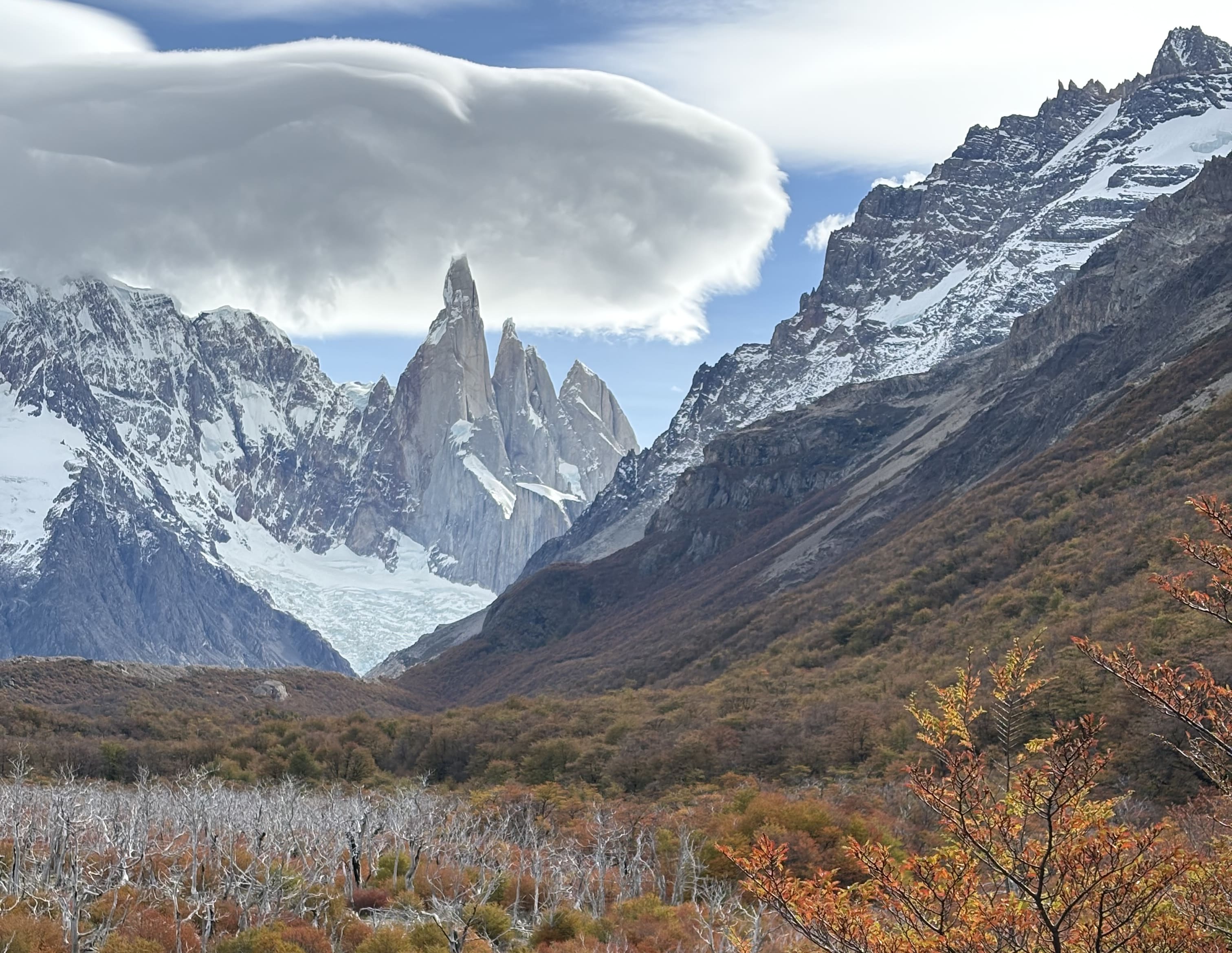
Today’s on the agenda: a real marathon of a day. The alarm goes off at 5:30 am—it’s pitch dark and freezing outside, but: it’s photographer time! If you’re traveling with photographers, here’s something you should know: you need to be out there at least an hour before sunrise—tripods, filters, lenses… it takes time. I kill the waiting time like any professional would: phone in hand, snapping a mini photo story of my colleagues as they set up in the dim light and focus. The result? Mixed. The mood? Honestly, a little disappointing. So, it’s settled—we’ll do it again tomorrow. But with better light!
After a quick breakfast (Lisa kindly gives us 30 minutes), we’re off: Hike to Laguna de Cerro Torre – 22 kilometers, no mercy. The pace is intense. The goal: be back by 6 pm—and have a relaxed picnic by the lake in the afternoon. The only problem? The return journey alone takes three hours… so it’s all about hiking fast, staying on track, and no dawdling.
The landscape? Absolutely mind-blowing: autumn colors, golden leaves, clear skies—and Cerro Torre always in sight. Lisa tells us how unbelievably lucky we are with the weather—seeing the Torre completely clear is rare. Jackpot! The hike is dreamy but demanding—constantly uphill. And by the end, my shins make their presence known, reminding me that I’m very much alive.
Back at the hotel, there’s a quick shower (feeling like I’ve used up my last ounce of energy) and at 7 pm: reward in the form of steak — we’re going to eat like kings. And let me tell you, it tastes even better when you’ve hiked through Patagonia for half the day.
Tomorrow? 4:30 am wake-up. But I’m not thinking about that just yet. Right now, I’m just thinking: What a day!
Day 8: El Chaltén – sunrise, shin burn, & self-made pasta
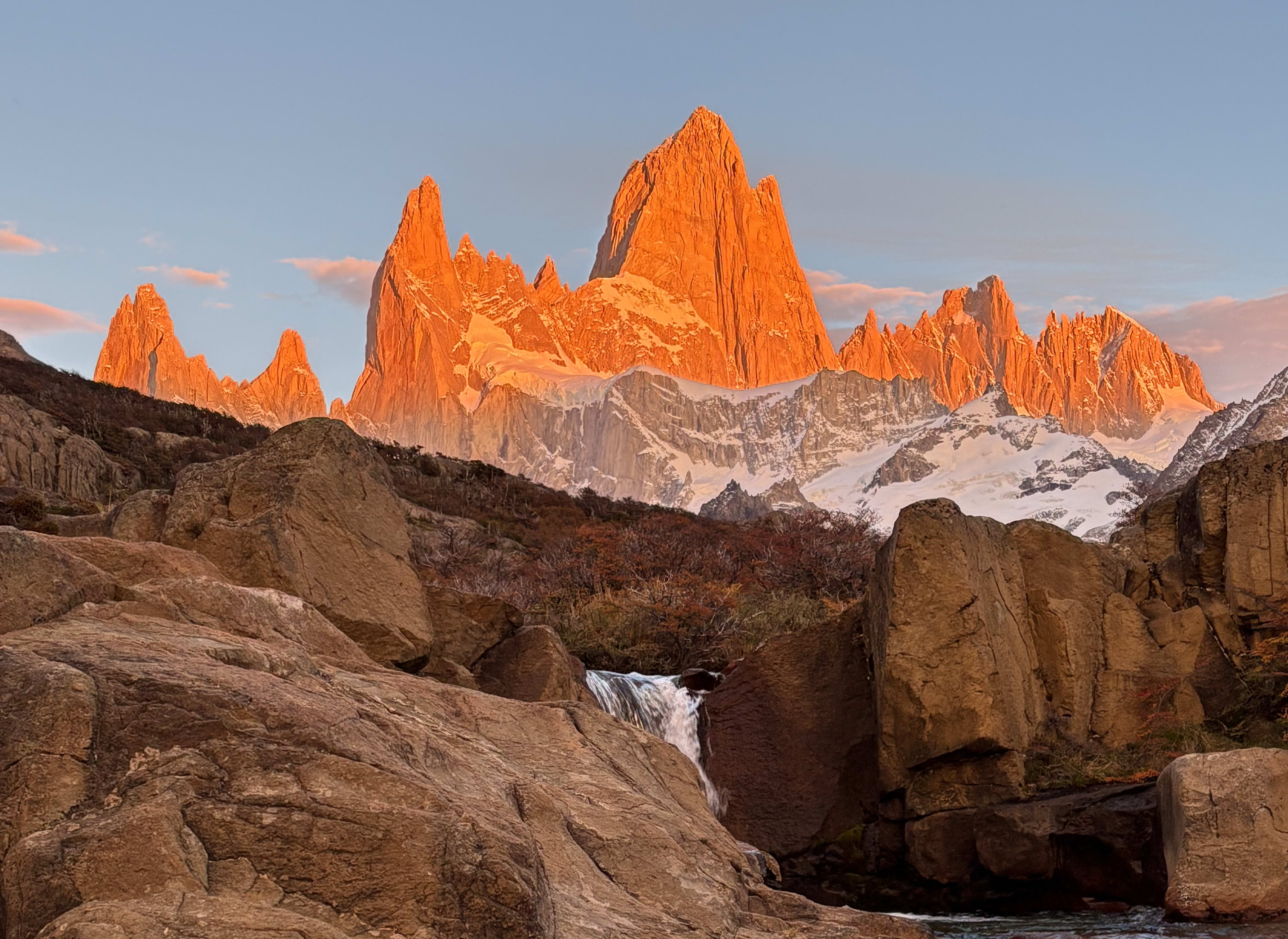
Today marks another one of those “just a quick hike up the mountain” kind of days. Five kilometers before sunrise—with a headlamp, biting wind, and tired legs. The destination: a special spot right before the majestic Fitz Roy Massif, near the Chorrillo del Salto waterfall.
Up top, things get wild: Several photo tours are already there, including a group of Chinese photographers who bring statistical perfection and early-bird energy. The best spot by the waterfall? You have to fight for it. But hey, this is Patagonia! My shins are screaming again, but I push through. And honestly? I’m surprised at how good I feel despite the effort. And then: the sunrise. The first rays of light touch the rocky spires, the towers glow, and for a moment, it feels like nature just hit the “showtime” button. Absolutely breathtaking.
After this highlight, it’s an easy downhill – more than six hours of hiking in total. But the reward? Waffles. Sun. Contentment.
“In Patagonia, the wind lives,” they say, but we experience nothing but perfect sunshine every day. El Chaltén remains an absolutely mind-blowing place: At the end of the world, but full of life. I watch the buzz, lean back, sip a well-earned beer, and think: Yeah, life is pretty good right now.
In the evening, we switch things up at “Maffia” – homemade pasta instead of steak. Delicious – and exactly the variety needed after so much meat.
A perfect day of glowing peaks, hiking, feasting — and a fresh dose of muscle soreness.
Day 9: Last day in El Chaltén – wind, wheat, & wow moments

As always, we’re up early in the cold wind – tired, but filled with anticipation. Cameras ready, fingers half-frozen, and the hope high: for magical morning light. Today, we finally feel it—the legendary Patagonian wind. It tugs at our hats, rattles through jackets, and quickly brings you to full operating temperature. But: It’s worth it. We’re rewarded with a fantastic sunrise. The peaks start glowing. The landscape awakens—and we’re right in the middle of it. Speechless.
After breakfast, we head back out – 15 kilometers of hiking, but this time with no rush. No goals, no time pressure, no fight for the perfect shot. Just: Being outside.
The landscape is—as always – jaw-droppingly beautiful. Autumn colors glow, the sky is clear, and the wind dies down. Today, it’s just the four of us, and we enjoy a little picnic by the stream. I fill my water bottle with fresh glacier water—it tastes like freedom. We take our time, snap some photos, talk a little. The silence is loud enough.
Now, after five nights in El Chaltén, around 70 kilometers of challenging terrain, and countless impressions later, I’m tired—but also: proud. Proud of my legs. Proud of my photos. Proud to have been here.
Back in town, I treat myself to a well-deserved wheat beer in the beer garden. The sun is shining, the body is exhausted—but the heart is full. El Chaltén—you crazy place at the end of the world. Relaxed, carefree, full of charm and nature that humbles you.
I’ll be back. For sure.
Day 10: Bye bye, El Chaltén – hello, Chile!
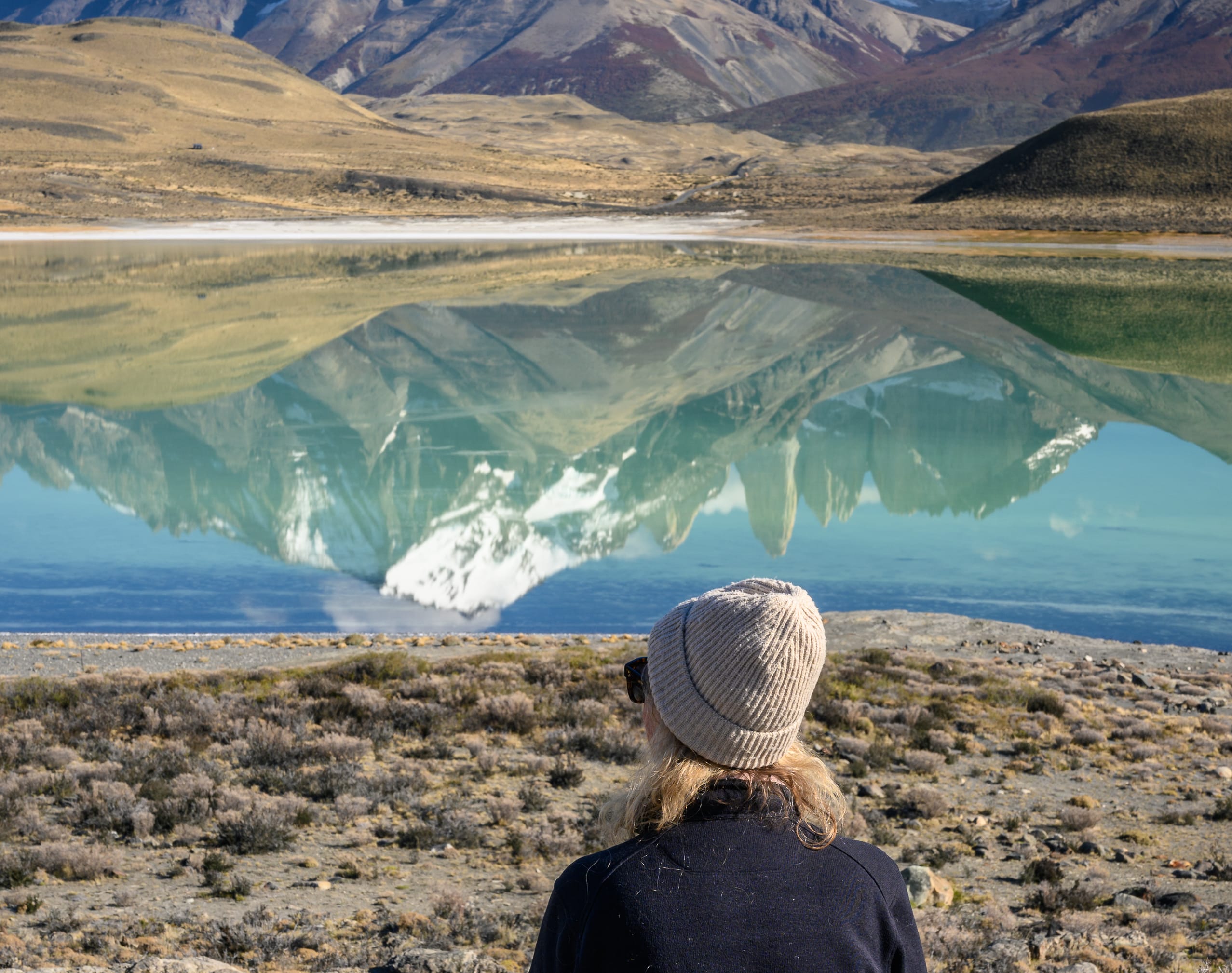
After five nights, around 70 kilometers of challenging hiking trails, unforgettable sunrises, and what feels like a thousand photos, it’s time to say goodbye to El Chaltén. And of course, early morning starts are a must.
We take the public bus to Chile — our next destination: Puerto Natales, the gateway to Torres del Paine National Park. The ride is long. Six hours across the Argentine pampas – endless steppe, brown plains, dusty gravel roads. Hardly any cars, no houses, no animals. Just rocks, wind, and sky. They say “in the pampa” is symbolic for “the middle of nowhere,” and after this stretch, I can confirm: That saying is spot-on.
The border station is a small hut, tucked away somewhere in the middle of nowhere. The border formalities? Easy-going. After a quick check, we’re officially in Chile. And the weather? Surprisingly mild – 14°C!
Arriving in Puerto Natales, you immediately sense the difference: A small town, but with character. Originally inhabited by the indigenous Kawésqar and Tehuelche peoples, the region was discovered in 1557 by seafarer Juan Ladrilleros — who named it “Última Esperanza” (Last Hope), as it was his last chance to find the Strait of Magellan. Dramatic? Maybe. But somehow fitting for this wild, rugged corner of the world. The town itself was officially founded in 1911, growing as a harbor for the booming sheep-farming industry, attracting people from all over Europe: Brits, Germans, Croats, Spaniards, Greeks. A melting pot in Patagonia.
We stroll through the streets, exchange money, drop off laundry (much needed after all the hikes!), and pick up a few essentials.
In the evening, we meet Ricardo, our guide for the coming days in Torres del Paine, and celebrate our arrival in style with an amazing dinner.
And then: Calafate sours. This cocktail of Patagonia packs a punch—a mix of calafate berry syrup, Pisco, lemon, sugar, ice...and sometimes egg white. Sweet, fresh, dangerously delicious. Totally my thing. After a few glasses and lots of laughter, it’s early to bed. Tomorrow brings the next adventure. Torres del Paine—here we come!
Day 11: Chile – sunrise, horses, & full Patagonian vibes

We start the day like true Patagonia pros: early, with hats, cameras, and freezing fingers. Before breakfast, we head down to the pier of Puerto Natales. Honestly, it’s a nice change of pace. No uphill climbs, just standing still and taking it all in. The old wooden pier stretches out into the lake, with mountains in the background – a truly photogenic spot, with its own charm. It’s calm, no tripod wars, just a bit of morning peace to kick off the day.
After sunrise, we head back to the hotel—and finally, breakfast! Now, let’s be honest, breakfast in Argentina and Chile is... pretty basic. Toast, butter, jam, eggs. Maybe some fruit if you’re lucky. The coffee? Well, let’s just say it’s not the highlight of the day. I’ll take it with humor—caffeine is caffeine. Then, the next adventure begins: We’re going on a horseback ride to a traditional Estancia.
The landscape opens up with wide fields, mountains on the horizon, and right in the middle: our small group riding Chilean horses. The pace is easy, the horses relaxed—just like us. It feels almost like a little Western movie, minus the cowboy hats—but full of nature and freedom.
In the afternoon, the highlight awaits: Barbecue and red wine. The meat comes straight from the grill, juicy, smoky, and perfect. Paired with a glass of Chilean red wine, which tastes even better in the sun.
We laugh, eat, toast—and just enjoy the moment. Chile, we’re already loving you.
Day 12: Torres del Paine – wilderness from another universe
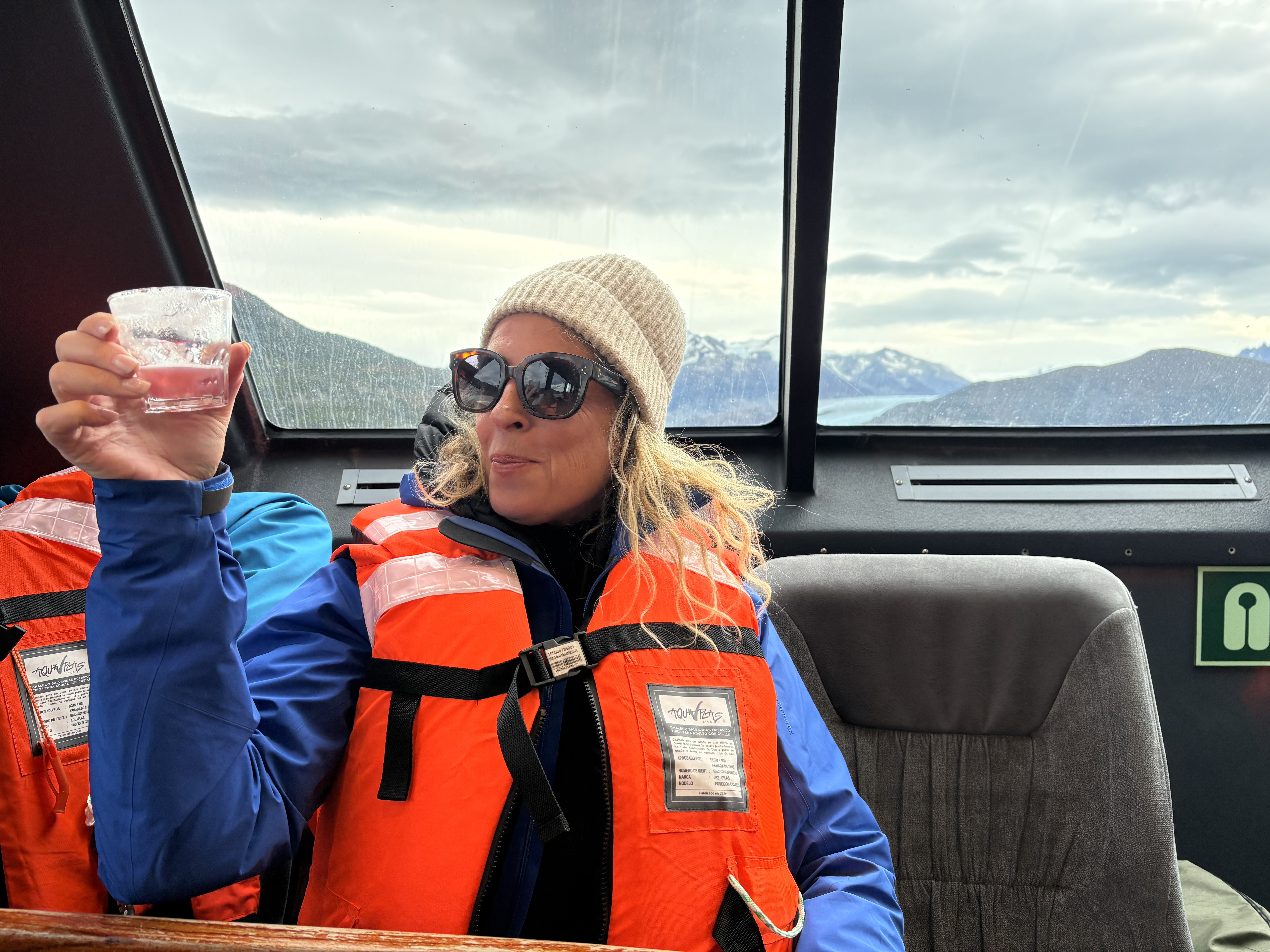
We’ve arrived. Torres del Paine—just the name sounds immense. And it truly is. This national park in the southernmost part of Chile is considered one of the most spectacular natural areas in the world—and after just a few kilometers, you understand why. Here, mighty granite peaks meet turquoise glacier lakes, Andean condors soar in the sky, and somewhere out there, pumas roam the steppe. These are the images you associate with Torres del Paine—but in real life, everything is even grander. More intense. Wilder. More real.
Before we dive in completely, let’s take a moment to appreciate the land that welcomes us: Chile is a geographic wonder in itself—over 4,000 kilometers long, but only about 180 kilometers wide on average. From the driest place on earth (the Atacama Desert) to the eternal glaciers of Patagonia, it offers an incredible range of landscapes. And you can feel that Chile has a different vibe compared to Argentina. While Argentina often struggles with economic crises, inflation, and chaos, Chile stands as the more stable country—with a modern infrastructure, a better-developed social system, and a comparatively resilient economy. Not perfect, but definitely different. You can feel it in everyday life: Prices, quality, order—it all feels more structured. And yet, the way of life is unmistakably South American—relaxed, warm, and genuine.
Back to the wilderness: And then there’s the light…They say the sky here is different. You can’t explain it—you have to see it. Every few minutes, the weather shifts – sun, storm, rainbow, snow. The cloud formations are often spectacular, shaped by the mountains, wind, and moods of the weather. But today, we’re lucky. Or should I say, we’re experiencing a meteorological miracle. What we’re witnessing is anything but normal: Clear blue skies. No clouds. No wind. And this goes on for days. For us, this means perfect conditions for photos, hikes, and unforgettable moments.
After breakfast in Puerto Natales, we begin our journey into the park—driving along the Ruta del Fin del Mundo. The landscape is already breathtaking, but the day’s highlight is yet to come: a boat ride to the Grey Glacier. The water glistens with a silvery-blue hue, and in the distance, the massive glacier wall of Glacier Grey rises—wild, majestic, and awe-inspiring. We stand on deck, letting the breeze touch our faces (a light one, at least), and what’s the perfect companion for such a moment? Of course, a Calafate sour—ice-cold, served with a view of eternal ice. It doesn't get any better than this.
We’ll spend the next six nights in the park. And as if all of this wasn’t spectacular enough, the upcoming days promise even more spine- tingling moments: Three days of Puma Tracking. We’ll venture out with expert guides in search of the mysterious predators of Patagonia. With a bit of luck (and patience), we might spot them—from a safe distance, of course—in their natural habitat. It’s a real highlight, the kind of experience you’d expect to see in a nature documentary. If there was ever a place in the world to take the perfect photo, it might just be here. This is what true wilderness feels like. Far from everything. No cell service. No signs of civilization. Just raw, untamed nature. Guanacos graze, glaciers calve, the wind is (for once) quiet—and in the midst of it all: us. At the cold, wild end of the world. And that’s exactly why we’re here.
Day 13: Pumas, panoramas, & Patagonian flow – our tracking days begin
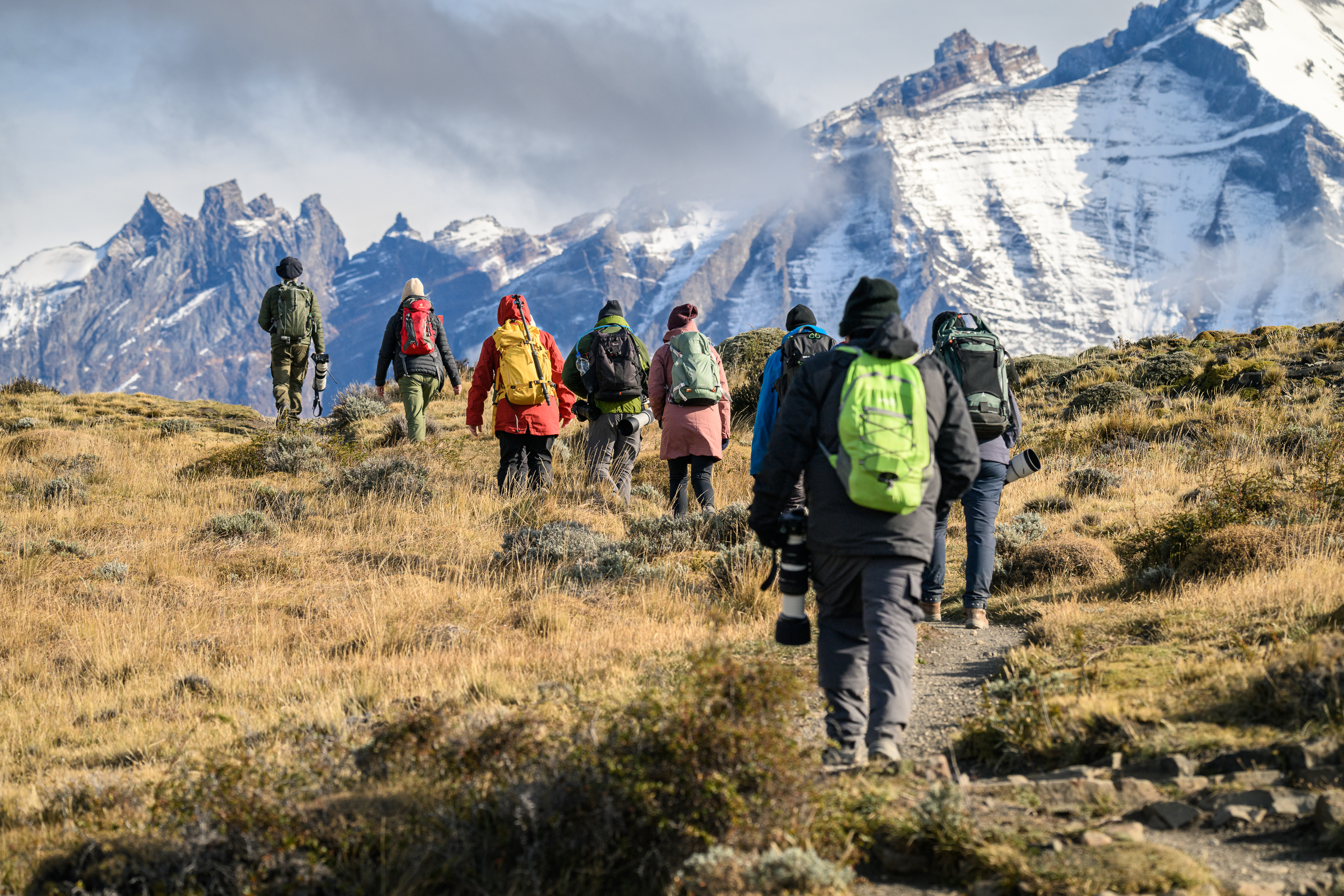
A silver snake of a river winds beneath us, cutting through a vast yellow-green valley. Surrounding us: towering mountains, glaciers in the distance, a panorama that feels like something out of a painting—as if someone had stretched a giant canvas across the horizon. To the far left, nestled in this scene, are a few green roofs by a river bend—our hotel for the next six nights. What a place!
The day begins as it should in Torres del Paine: 6 am, coffee in hand, camera ready, and out into the cold. First stop: sunrise—today at Portería Amara. And as always, it’s spectacular. The sun slowly creeps over the peaks, bathing the landscape in soft light—the first goosebumps of the day. Afterward, we meet Ricardo and his colleague—the two guides who will accompany us over the next three days, as we embark on our puma tracking adventure.
Today is a warm-up hike—walking, observing, and scouting. We haven’t spotted any pumas yet, but we have plenty of time for a small photoshoot and a relaxing picnic by Cascada Paine. We’ll be back here in the coming days—it’s the perfect spot for sunrise. So, we mark the location, study the light, and take note of everything.
In the evening: sunset directly from the hotel—with a view like this, words aren’t really necessary. Just sit back, look, and marvel.
The next few days will likely feel similar: Early mornings, chasing light, searching for pumas, celebrating nature. I’m ready—and honestly, I’m already a little in love with this wild corner of the world.
Days 14–17: On silent paws – our first puma!
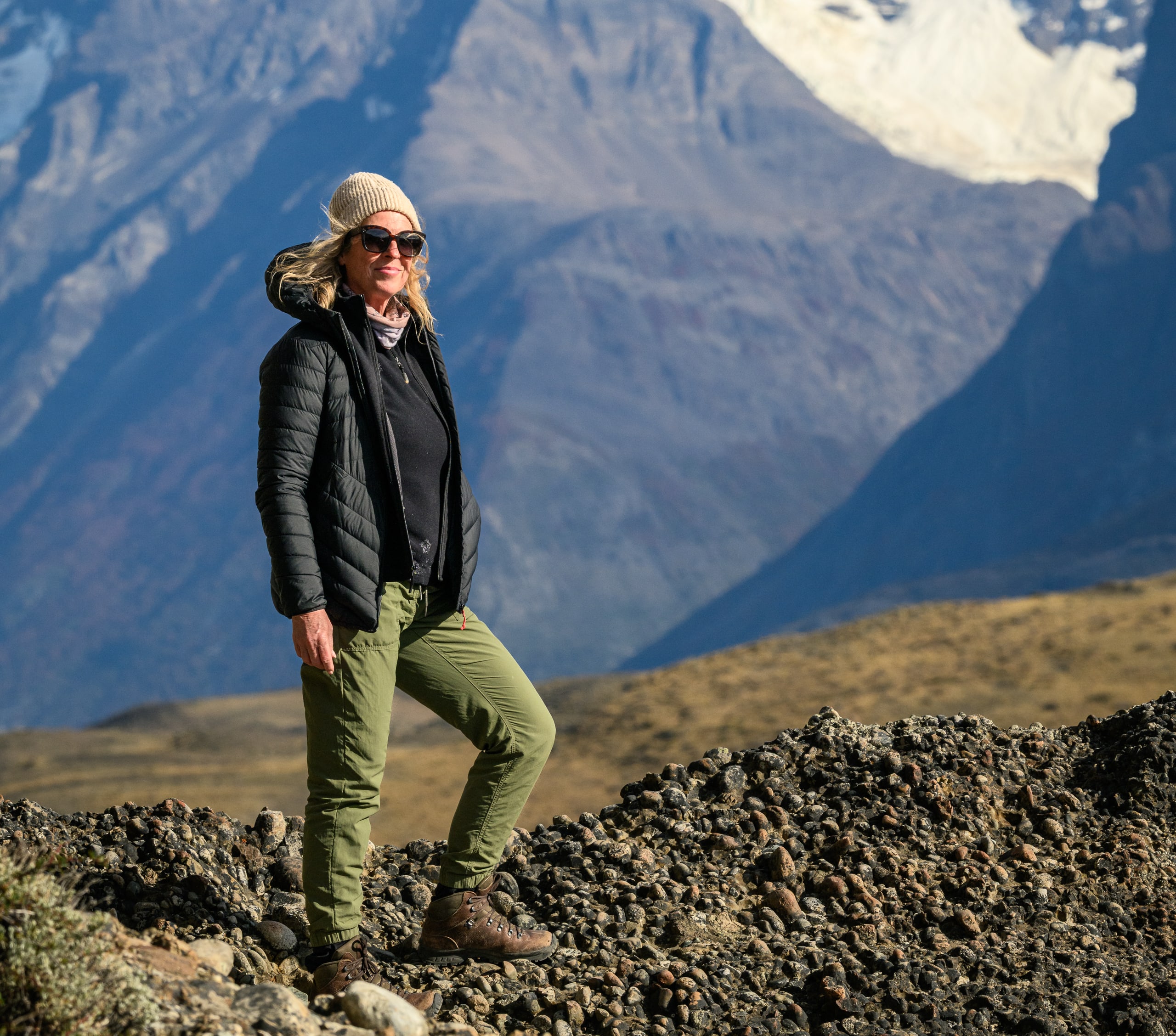
As is often the case in Patagonia, the day starts early and frosty—with a spectacular sunrise at Mirador Laguna Amarga. The Torres del Paine glow in the first light, the sky paints a colorful display in pink, orange, and gold—a sight that takes your breath away. Camera out, fingers half-frozen, heart full.
Next, we head to Cascada Paine, this time specifically to capture the perfect shot. We know the spot from the previous day, but today, the light is just right. And as always, in Patagonia, no place ever looks the same twice.
Late morning brings our highlight: Puma tracking with Ricardo and his colleague. We cruise through the vast steppe in the 4x4, with the trackers patiently explaining what to look for: The behavior of the guanacos, tracks in the soil, wind direction, slope—it’s like piecing together a puzzle of nature. And then—after barely 30 minutes—the moment arrives: “There it is.” A puma, calm, powerful, and composed. A quiet, intense moment. No spectacle, just pure presence. Our puma is a female, and unfortunately, we can only see her from a distance. But still, we watch, photograph, and stay silent. Goosebumps all around.
In the evening, the grand finale: A sunset at Lago Pehoé, right by the campsite. The light is golden, the water is as smooth as glass, and the mountain silhouettes dramatically reflect in the lake. It’s one of those moments where you almost forget to take photos—because you just stand there and marvel at the beauty.
A day full of wilderness, light, and a deep sense of joy.
Day 15: Camera battle at Lago Pehoé — and a day Following the pumas
Today, we start early to secure a spot for the next sunrise at Lago Pehoé — because this location is highly contested. We’ve chosen our spot carefully so that the Cuernos (the “Horns” of the Paine Massif) will be lit by the rising sun. We scouted it out a few days ago, knowing that in the dark, everything is hard to assess. When we arrive, we’re in for a surprise: There’s hardly any space left. Tripods stand shoulder to shoulder, and every inch of the shore seems reserved. The mood is—shall we say—tense. There’s a faint scent of territorial disputes in the air, with mildly aggressive glances thrown around. Everyone wants “their” spot for the perfect sunrise. But hey, that’s just part of the deal here. We manage to secure a semi-decent spot and take it with good humor.
Afterward, we head back to Mirador Laguna Amarga—this time for a photo stop with perfect reflections. The water is still, the sky clear, and the Torres mirror themselves like a scene from a picture book. It’s a dream for any wide-angle lens.
Late morning brings more puma tracking—once again with Ricardo. We learn so much: how truly elusive pumas are and why they’re so hard to spot. Ricardo tells us that almost all major puma documentaries—whether from the BBC, Netflix, or NatGeo—were filmed right here. Some of the animals were followed for years, getting accustomed to the calm, respectful presence of the camera crews. He also explains a lot about the guanacos, the secret puma detectors: Their calls, body language, and alertness are all signs of potential predators nearby. And, if a puma has taken down a guanaco, it will feast on it for several days. A dead animal is often a clear sign that a puma is in the area. Today, however, luck isn’t on our side. We search in the morning and again in the late afternoon—as the cats usually rest during midday. No sightings, but plenty of tracks, a lot of knowledge, and a breath of fresh air.
In between, we take a short excursion along an educational trail, hike through the impressive landscape, and simply enjoy the scenery—because, after all, that’s what it’s all about.
Day 16: Above the clouds, Under the Febreze – another day in Patagonia
We witness one of those goosebump-inducing sunrises you’ll never forget: Above the fog, just near our hotel. The morning is icy, but the light is magical—the sun breaks through the thick fog, coloring the peaks in pastel hues, while below, everything is still asleep. A moment for the soul. As usual, the day continues with puma tracking—unfortunately, once again without success. The cats are taking their time! We take it in stride and use the free time for something else: a photo shoot with the whole group at Lago Pehoé. Great mood, great people, great light—that’s all you need for some beautiful photos.
Next, we head to the next natural highlight: We visit Salto Grande Waterfall—roaring, powerful, and impressive. From there, we hike about six kilometers to Mirador Cuernos, where we have a picnic. And yes, the view? Once again, spectacular. The Cuernos (the “Horns” of Paine) rise dark and dramatic into the sky, while we enjoy our sandwiches. Patagonia delivers yet again.
On the human side of things, everything is going smoothly: The group dynamics are great, and I especially get along well with Kerstin. We’ve become a well-oiled team—even our daily routines are almost synchronized. The only downside: Our clothes are running out. In the room, it’s starting to smell... let’s say, authentically Patagonian. We could probably compete with the guys—it smells like adventure. Kerstin’s solution: Febreze on the socks. I’m laughing so hard.
As always, we’re back at the hotel late. After a hearty dinner and a glass of wine, we simply fall into bed. Tomorrow, we continue.
Day 17: Fairytale forest, miscelaneo, & a puma!
The day doesn’t start with sun and glory, but with gray sky and damp air—but that gives our hike along the Río Serrano a special touch. It’s quiet, damp, misty—almost enchanted. Moss hangs from the branches, the light is diffuse, and we take our time. No schedule, no pressure – just us and the fairy tale forest.
Afterward, we head to the national park’s visitor center, where we learn some fascinating facts about Torres del Paine: geology, wildlife, conservation efforts—it’s always good to understand the landscape more deeply.
In the afternoon, we take the circular Miscelaneo trail. The name might sound unassuming, but the perspectives are entirely new. We see the area from above, with wide views over valleys and steppes. Of course, we also have pumas in mind. During our picnic at the campsite, we recharge before heading back into puma territory in the early evening. And then – finally – movement on the slope. A puma, very far away, but unmistakable. A few photographers from our hotel are already there, watching the spot. It’s our driver Patrizio, who truly recognizes the situation, with a trained eye and full commitment. We jump out, race up the hill, tripod in hand, breath shallow, hopes high. And then: We wait. Will it move? Will it come closer? Will we see it better? But no—it stays where it is. A gray dot in the distance. But hey—a puma is a puma.
Need to know
More than photos
It’s hard to explain what exactly a journey does to you. Maybe it’s not so much what we see—but what it changes inside us. There’s that moment when you board the plane, with no clue what awaits. And then, weeks later, all the small and big moments come together, like pieces of a puzzle inside you. Not perfect, not always comfortable, but somehow exactly right. Because travel isn’t consumption. It’s an experience stored up for later.
A trip changes you, even if you don’t notice it right away. And sometimes, it’s the moments in between—the waiting, the failure, the watching—that stay with you the longest. For me, this trip was more than just kilometers and photos. It was connection, realization, and real moments of being outside. And it was an experience with people who have their own unique view of the world—the photographers I was traveling with.
I learned how much planning, patience, and precision go into a great picture—and how it feels to argue at seven in the morning about which hill has the best light. I learned how to adapt, be considerate—and still stay true to myself. I learned so much about the others. And even more about myself. What remains is the silence in a fairy-tale forest. The roar of a waterfall. The laughter at the picnic spot. And the longing that now resides somewhere inside me—for more.
Because the true gift of travel isn’t the places you reach. It’s the marks they leave on you.
Patagonia, I thank you. For your rugged beauty. For the light. The colors. For laughing with strangers, cursing uphill—and marveling at the top. For curious foxes, sturdy hiking boots, Calafate sours, and fog over lakes. For pumas in the distance. For waffles after 15 kilometers. For every “Wow,” every “Look at that!” and every silent moment of awe. For the adventure. For the magic. And for the people I got to share it all with.
Thank you, Patagonia. You stay with me.
For more inspiration and insider recommendations, visit our South America page.
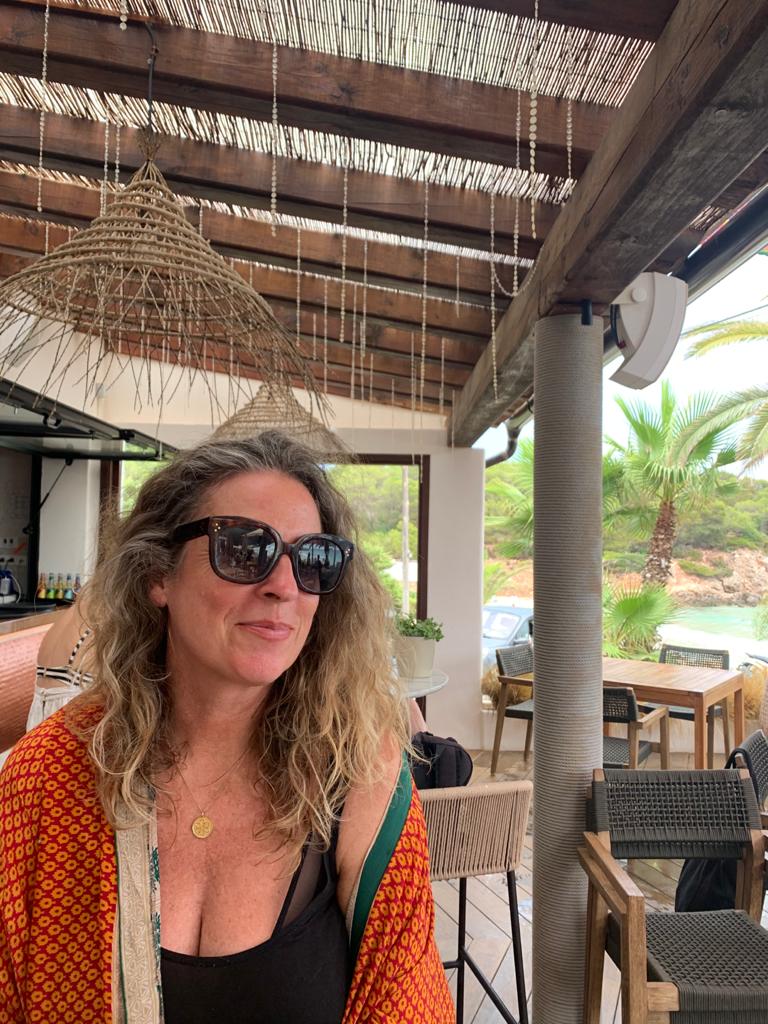
Travel Advisor
Norma Kroeger

Get in touch with Norma
Did you like this guide? Reach out to customize and book your own experience. Or, just to chat about travel in general.
You can expect a response from Norma within 1–2 business days. You’ll also be subscribed to our traveler newsletter (you can unsubscribe at any time).